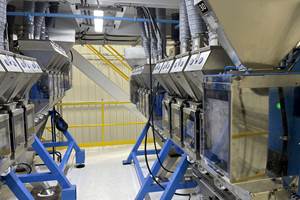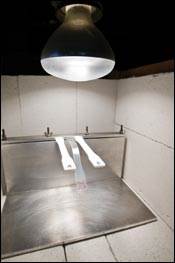NPE News in Additives
Colorants were the most numerous class of additives making news at the huge triennial plastics exhibition last month in Chicago. Some of the new colorants were aimed at specialized applications, from natural-fiber composites to laser marking, while others were for aesthetic special effects, such as color shifts and diamond-like sparkle.
The color "green" applies figuratively to several new additives tailored for renewable biopolymers or designed to make conventional petro-based resins biodegradable. Some other new entries have an environmental slant, such as odor-masking agents for recycled plastics and non-halogen flame retardants. Green might also symbolize the cost savings that a number of new products are said to afford through reducing resin consumption or other economies in use. Overall, the new products encompassed fillers (hollow and otherwise), foaming agents, antifog agents, mold releases, heat and light stabilizers, and a number that impart special properties such as scratch resistance, infrared reflection, and X-ray opacity.
ENVIRONMENTAL EMPHASIS
New additives that help make plastics more environmentally acceptable constituted one theme at NPE exhibits. For example, Teknor Color came out with a range of color concentrates for Mirel PHA biopolymer from Telles, the joint venture of Metabolix and Archer Daniels Midland. Developed in partnership with Telles, the new concentrates are suited to injection molding, sheet and film extrusion, and thermoforming. Several colors are already being used in Mirel laboratory material-handling trays and consumer products, and a black concentrate is being used in field trials of Mirel agricultural mulch film. This is not Teknor Color's first venture into this blossoming field—it previously launched color concentrates for PLA biopolymers. (See Learn More box for more on additives for biopolymers.)
Two other exhibitors showcased new additives that make conventional plastics biodegradable. Felix Composites, a Canadian custom compounder, showed off its DCP Degradable and Compostable Plastic Additives for polystyrene and polyethylene. These additives are said to promote oxo- and bio- degradability and compostability in single-use disposable products that typically end up in landfills or carelessly tossed away outdoors.
Another new degradability promoter was introduced by BIOtech Products (exhibiting with Kenrich Petrochemicals), which offers an additive that reportedly makes PVC and some other resins 100% biodegradable in a landfill. The formula is said to be nontoxic and contains no starch, heavy metals, zinc, bleaching agents, or phthalates. In 2005, BIOtech first launched BIOflex, a biodegradable, flexible sheet product for use in billboard signs. It is based on PVC, fine-particle limestone, vegetable-derived plasticizer, and titanium dioxide pigment. More recently, BIOtech Products began marketing this formulation under the name BIOchem for use as an additive in all types of PVC products. According to independent tests, adding about 2% will help PVC degrade completely to methane gas and soluble chloride within three to five years. BIOchem reportedly also works in polyvinyl acetate and EPDM and the company thinks it will work in PE and PP as well (tests are under way).
Wood and other natural-fiber additives are finding increased favor in plastics, partly as a means of increasing the "renewable-resource" content of polymer compositions. PolyOne presented new colorants and additives to improve aesthetics and end-product performance of plastic compounds with a variety of cellulosic fiber materials, including rice hulls and recycled cardboard. These additives are intended to address such issues as uniform coloration, UV stability, mold/mildew resistance, water absorption, thermal expansion, scratch/mar resistance, and resin/fiber compatibility.
Wood-plastic composites are often based on recycled plastics, and recycled materials are often subject to contamination that can leave residual odors. Such materials could make use of a new ZO Series of Odor Management masterbatches from Polyvel, which are designed to absorb, neutralize, or otherwise mask odors. These customizeable products are typically based on PP, HDPE, LDPE, or EVA for use in polyolefins and nylon. They are dust-free pellets and are typically let down to 0.1% to 5% use level. Some grades have food-contact approval.
PolyOne introduced an additive masterbatch that upgrades recycled engineering resins such as PET, PBT, PC, and nylon—as well as PLA biopolymer—by restoring molecular weight degraded by reprocessing. OnCap Chain Extender can increase viscosity by more than 15%, with corresponding improvements in melt strength and mechanical and thermal properties.
SPECIALTY COLORANTS SHINE
In the additives realm, specialty colorants were the stars of the show. In addition to the examples cited above from Teknor and PolyOne, another example is nGrain masterbatch from Americhem. Introduced last fall, it is said to provide true-to-life simulated woodgrain effects in building profiles of ABS, ASA, acrylic, PE, PP, PVC, and PS, as well as wood-filled compounds. It is said to be a more durable and lifelike effect than is obtained with woodgrain film laminating.
EMD Chemicals brought several new pigments to the show. One was Laserflair 8840, the latest addition to the company's line of laser marking pigments. This copper-based product is neutral in color and is said to have higher laser sensitivity in the ND:YAG emission spectrum and give higher edge sharpness. Because it absorbs laser energy, it can also be used in laser welding and is said to enable higher welding speeds.
Also new from EMD Chemicals were several pigments for aesthetic special effects. Illustrating the current fashion for color-shift pigments, EMD recently introduced Colorstream T10-06 Royal Damask and Colorstream T10-05 Pacific Lagoon. The first provides "color travel" from "noble red to bronze to aged gold," depending on viewing angle. The second shifts from turquoise to blue to violet. Both are mica particles with metal oxide coatings. They offer high transparency and meet FDA, CONEG, and REACH requirements.
A subtle shift from rich gold to green is provided by new Iriodin 325 Solar Gold Satin, a mica-based pigment that adds a metallic effect with high luster and color intensity. It also meets FDA, CONEG, and REACH regulations.
Another new EMD pigment is said to provide a diamond-like sparkle and glitter. Miraval 5511 Starlit White consists of relatively large particles (30 to 300 microns diam. x 5 microns thick) of calcium aluminum borosilicate with a metal oxide coating. It complies with FDA, CONEG, and REACH.
Also new is the Miraval Scenic Series, with similar composition, which provides copper, gold, and turquoise glitter effects. These have half the particle size of the existing Miraval Magic pigments.
In addition, EMD Chemicals offers a new treatment for its Iriodin special-effect pigments. Iriodin WM10 Industrial Pigments are predispersed in a low-molecular-weight polymer to provide higher throughput and other advantages for masterbatchers. Enhanced versions of EMD's Iriodin WM8 series, they prevent dusting and clumping and enable faster and more complete dispersion and much faster equipment cleanout. WM10 pigments are said to work well with PE, PP, and flexible PVC.
Holliday Pigments of the U.K. showed new developments in ultramarine pigments for plastics together with its U.S. distributor, Brenntag Specialties. Three new additions to Holliday's Premier and Prestige ranges are slightly redder than the previous grades. The new entries are a standard version, a very dry grade for highly loaded color concentrates, and a low-dust Prestige grade, which uses a low-molecular-weight carrier resin.
Also new is Holliday's 6117 (Premier XAR) acid-resistant grade. It is for applications like stadium seating, which is exposed to both acid rain and strong sunlight. An inert coating on the pigment particle adds acid resistance and light stability. With previous acid-resistant coatings, the coating could abrade during pigment dispersion and reduce acid resistance. Premier XAR coating is said to be more abrasion resistant, giving 50% better acid protection.
FILLERS SAVE $$
Heritage Plastics has long touted the advantages of using fine-particle, surface-treated calcium carbonate in films and blow molding to reduce resin cost, save energy, increase throughput (through faster cooling), and boost physical properties, barrier, and ESCR while reducing warpage. Now it is offering injection molders similar savings and benefits through use of its HM10 and PolyMax LLDPE and HDPE concentrates and HiCal PP concentrates of approx. 80% calcium carbonate. A leading cap molder recently used PolyMax concentrate and found that the whitening effect of the filler reduced his pigment costs as well.
A very different kind of filler product is a new masterbatch of nanoclay in nylon 6 from Techmer PM. This product is said to greatly improve the physical properties of nylon 6 film without increasing the density. It was developed to enable downgauging in an industrial film application.
Two other firms showed off improved grades of hollow microspheres. Potters Industries introduced lightweight grades of Sphericel hollow glass spheres—34P30 (0.34 g/cc) and 25P45 (0.25 g/cc)—for use in nylon, PBT, and PP.
Meanwhile, Eka Chemicals is highlighted new grades of Expancel expandable polymer spheres with higher temperature resistance—up to 400 F.
LIGHTWEIGHTING WITH FOAM
Another way to save on resin usage is by foaming to reduce density. Reedy International proposes to cut costs further through use of its new Saftec XP-600 endothermic blowing agent, which is a free-flowing powder that is more economical than pelletized versions. It is a low-temperature foaming agent primarily for polyolefins and vinyl.
Americhem has come out with a line of optimized blowing agents called nCore. They are available in both powders and pellet masterbatches for injection molding, extrusion, and calendering. Endothermic versions are said to have an improved particle-size distribution that provides greater foaming efficiency. Exothermic types come with an activator tailored to the resin and process. Mixed endo/exothermic formulations are also available.
NO FLAME, NO HALOGEN
Environmental regulations are driving a trend toward non-halogen flame retardants. At NPE, four such products debuted from Techmer PM. Two FR concentrates, PBM13396 and PBM12635, are aimed at PET, PBT, and PTT fibers, films, and moldings. Both utilize the same proprietary ingredient that is said to enable finished products to pass UL 94V-0 tests at 18% loading. They also enable users to reduce melt temperature, but they do reduce the glass-transition temperature (Tg) and melting point of the resins.
Two other non-halogen FR concentrates are Techmer's PNM13649 for nylon fibers and film and PNM13319 for nylon injection molding. Both contain a nanoclay additive, which is synergistic with the flame retardant and makes it more efficient. They enable products to meed UL 94V-0, V-1, or V-2, depending on loading (15% to 20%).
Meanwhile, Techmer also introduced a non-blooming FR concentrate containing a brominated additive and antimony oxide for PE industrial bags, foam packaging, and other products that need good printability and heat-sealability. PM13800 can withstand extrusion coating at up to 610 F and reportedly has no adverse effect on foaming, unlike other flame retardants. It can be used in LDPE, LLDPE, and HDPE and also in injection or blow molded parts.
ADDITIVES FOR EVERY NEED
A handful of other new additive introductions at NPE are aimed at very specific applications:
•TPO scratch guard: Axel Plastics Research Laboratories has a second new product that improves the scratch and mar resistance of automotive TPOs and other polyolefins. MoldWiz INT-701S powder or pellet follows the INT-35CPD grade introduced earlier this year. Both products reportedly enable TPOs to resist scratch whitening at up to 15.4 N force in the ASTM D7027-05 test and 13 N in Ford Five Finger testing. The newer grade appears to be especially effective in TPOs with lower loadings of rubber and talc and in polyolefins with no rubber or filler.
MoldWiz INT-701S is said to be compatible with UV stabilizers, causing no surface film or droplet formation, such as occurs with additives that contain erucamide or oleamide. What's more, the additive reportedly causes dramatic improvements in impact resistance, apparently by helping create a more homogeneous dispersion of rubber and filler.
•X-ray opacity: NanoArc bismuth oxide from Nanophase Technologies is a nanoparticle additive that makes plastic medical devices radio-opaque to provide X-ray visibility.
•Infrared attenuation: Also new from Nanophase is NanoArc antimony tin oxide, another nanoparticle that can be incorporated into clear film and sheet to absorb infrared but not visible light. In products like skylights it prevents heating of the interior space.
Another new product in this area is an infrared-reflecting masterbatch for PE films and PP nonwovens from Techmer PM. It protects farm crops, cars, and buildings from the sun's heat.
•UV protection: Another new nano-additive from Nanophase is NanoArc zinc oxide, which provides UV protection without affecting transparency, gloss, color, or physical properties. An inorganic additive, it provides permanent protection to film, sheet, and molded parts and resistance to high processing temperatures.
UV protection of a different kind is the function of PolyOne's new OnCap UV Absorber for PET and PETG bottles and jars. At a letdown of 1% to 2%, the concentrate protects sensitive contents of the package from harmful UV rays. The product also contributes a blue tint to give a clean and bright appearance.
•Antifogging: New VF-152 antifog masterbatch from Polyvel is now available in an improved formulation that works faster and longer than ever before. It is suited to both hot and cold applications and is said to be FDA compliant at any letdown level. Thermoforming reportedly has no effect on its performance.
•PVC heat stabilizers: Yuntinic Resources, subsidiary of a Chinese firm that's the world's largest tin producer, has come out with two new organotin vinyl heat stabilizers. YT-186 is a methyltin said to provide improved cost/performance for weatherable capstocks and FDA packaging. It is based on chemistry similar to the firm's best-selling YT-181 methyltin.
The other, YT-813, is a non-sulfur-containing octyltin maleate said to greatly improve PVC's organoleptic (taste and odor) properties. It is aimed at rigid PVC for FDA packaging made by injection or blow molding, extrusion, or calendering. It can also be used in flame-retardant AB and PS.
•Rotomolding releases: Stoner, Inc. has a new line of water-based and solvent-based mold releases and mold cleaners for rotomolders.
Related Content
Tosaf’s Investments in North America Result in 40% Increase in Production Capacity
Backed by a global presence, Tosaf provides localized additive and color solutions, and services for the plastic industry in North America.
Read MoreSpecialty Purging Compounds Optimize Color and Material Changeovers
Selecting of the correct purging compound can speed up material and color changeover time and reduce scrap. You’ll even save on material.
Read MoreDSM Launches an AI Powered Color & Mechanical Properties Prediction Tool
Called Lucidiris, this prediction tool can reduce time to market when developing colors of high-performance materials for a variety of applications.
Read MoreNovel System Produces Color on Demand
Ampacet’s FluxQF technology features a quick-dispersion universal carrier with novel machinery that provides automated color blending in quantities down to 50 lb.
Read MoreRead Next
Enhancing Biopolymers: Additives Are Needed for Toughness, Heat Resistance & Processability
Plastics are going “green,” but they will need some help to get there. Biodegradable polymers derived from renewable resources are attracting lots of interest and publicity, but that enthusiasm is counterbalanced by persistent questions of availability, cost, performance, and processability. All these issues are inter-related: Increasing demand will lead to more capacity, which will presumably lead to lower prices. But the foundation is market demand, which ultimately depends on whether biopolymers will have the performance properties and processability to compete with existing non-renewable plastics.
Read MoreMaking the Circular Economy a Reality
Driven by brand owner demands and new worldwide legislation, the entire supply chain is working toward the shift to circularity, with some evidence the circular economy has already begun.
Read MoreRecycling Partners Collaborate to Eliminate Production Scrap Waste at NPE2024
A collaboration between show organizer PLASTICS, recycler CPR and size reduction experts WEIMA and Conair will seek to recover and recycle 100% of the parts produced at the show.
Read More




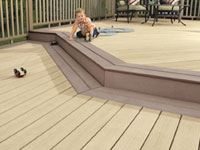

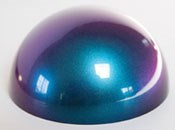

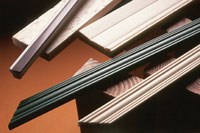











 (2).jpg;maxWidth=300;quality=90)











